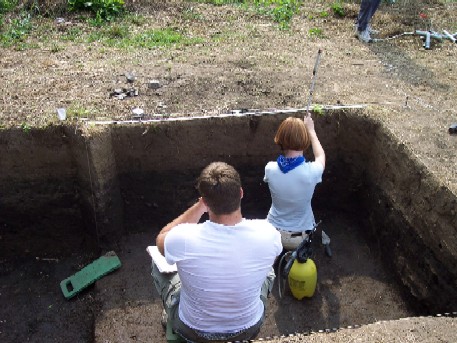
Field Projects: 2005-2011

| CASTALIAN SPRINGS ARCHAEOLOGICAL PROJECT Field Projects: 2005-2011
|
On June 6, we will be conducting an orientation lecture from 9:00 am until noon on the MTSU campus.
We will begin on-site preparations on June 7.
The things that they never show in the TV documentaries about archaeological projects are the intensive amounts of labor that go into "starting up" a project. Yesterday, several students assisted with transporting the three truckloads of equipment and supplies from MTSU to Sumner County that we will need for our project. Today, our morning began with "prepping" the tools and excavation area. Thanks to some help from Castalian Springs resident Lee Myers this morning, our excavation was trimmed from its current 3-4 feet of "hay in the making" down to ground level by mid-morning. After a second orientation session on "how to do archaeology" in the late morning, we broke for lunch. After lunch, we did the first thing that must always be completed on an archaeological project -- establishing the "site grid." Using surveying equipment, we lay out the north-south and east-west points that allow us to control precisely where our excavations are being conducted, exactly where artifacts, the remains of ancients houses, trash pits, and other items are found. The white flags and "glo-lime" flagging tape in the photograph below show the east-west line we established today -- they are at two-meter intervals. After constructing our "grid," we adjourned back to Wynnewood for a tour of that spectacular log resort hotel by Doris Myers, our long-time friend and caretaker of the property. On Wednesday, we will lay out our first four excavation units and begin exploring what we hope will be an area containing the preserved remains of Native American houses from about A.D. 1250.


Today, we began "breaking ground" at the field school excavation site. Our activities have been of tremendous interest to some neighbors about 50 feet to our east. The field team is divided into four "crews" -- each working on a separate excavation unit. Our excavation units are squares two-meters on a side -- all carefully tied into our recording system. Two crews are working on units on the southwestern edge of our project... The other two crews are on the northeastern corner of our project area... While the excitement was high with turning our first shovels of dirt today -- the temperature and humidity was stifling. None of the crew complained when it was time to break for lunch! After lunch, we had our "tent shelters" available to provide some relief from the heat (but not the humidity!). Each of the crews completed about 10-centimers of excavation today -- most of these early "shovels" were full of sod from the hayfield and upper soil zones disturbed by many years of plowing. Given our location in the floodplain of Lick Creek, we didn't expect to find much in this "first level" of excavation. As we proceed deeper into the ground -- below the area disturbed by plowing and covered with silt from flooding, we hope to find less disturbed and perhaps even intact remains of the activities of prehistoric Native Americans. Even in this upper disturbed zone, we are carefully screening all of the recovered soil for evidence of recent and ancient activities... And that evidence is already appearing in the form of cores and flakes of "chert" (or flint) that are the by-product of the manufacture of stone tools by Native Americans. While thus far they are few in number, we hope they will increase in quantity as we excavate further. More news tomorrow and the next day!



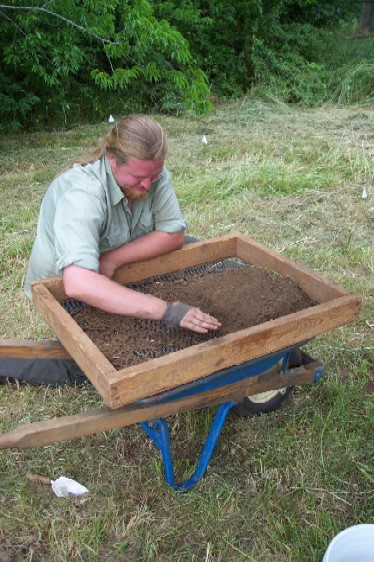

The day started off quite pleasant -- slightly overcast and not so humid as yesterday. Our project is -- first and foremost -- a course designed to train students in the methods, skills, and techniques they need to perform as professional archaeologists in future careers. As such, our progress during the first week is always slow from the "outside perspective" -- much of our time is taken up with individualized instruction. But, our crews are doing a super job of learning fast, asking questions, and making this intensive experiential learning process a success. Today, we focused on two specific areas -- surveying equipment and excavation technique. While our "site grid" provides the two dimensions of north-south and east-west, archaeological record keeping requires careful control in three-dimensions (including elevation or depth). We use a transit to maintain that third dimension. Below, Emily Reid is using our transit to take elevation measurements. While Brandy holds the receiving end of the survey measurements -- the "stadia rod." Keeping notes and records is a constant part of any archaeological project -- below, Gavin works on a detailed plan view of the excavations in one unit. At the same time, Mike is working on excavation techniques -- carefully cutting the side of the excavation unit to provide a clean and professional "side wall." And, although we are still in the upper "disturbed" soil zones of our excavations, we continue to practice the skills of recovering artifacts. After only two days, our "piles" of sod and dirt are already resembling enormous anthills. While we are still working in those upper plowed areas -- as we proceeded "deeper" today, some new discoveries indicate that we are definitely in areas that were used by native peoples over 800 years ago. Two very distinctive "arrow points" (known to archaeologists as projectile points) were found today. While perhaps not the types of exotic objects that excites the imagination of an average person, these two "points" are of great interest to us -- they are types of projectiles used during the period between A.D. 1000 and 1450. Precisely what we were hoping to find. Below, our field crew "hand models" are exhibiting those two finds -- the first is a wide triangular arrowpoint and the second is a narrower triangular arrowpoint. As the students learn techniques and skills and become more confident with their abilities (and more familiar with the "routines"), our progress will proceed more quickly.
Join us again tomorrow (and then next week) to keep up with our discoveries!


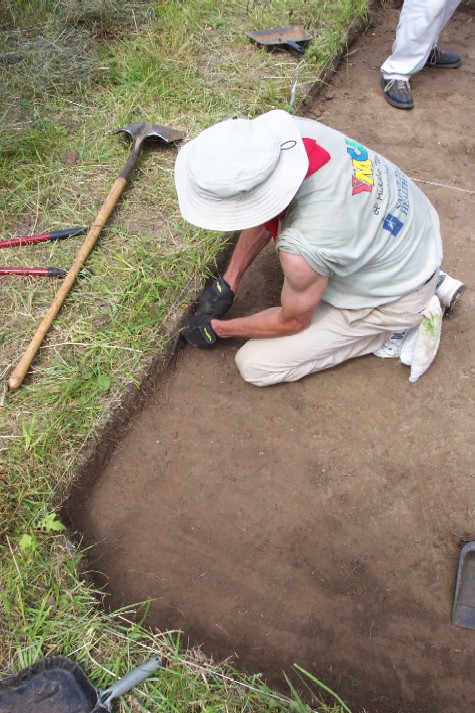
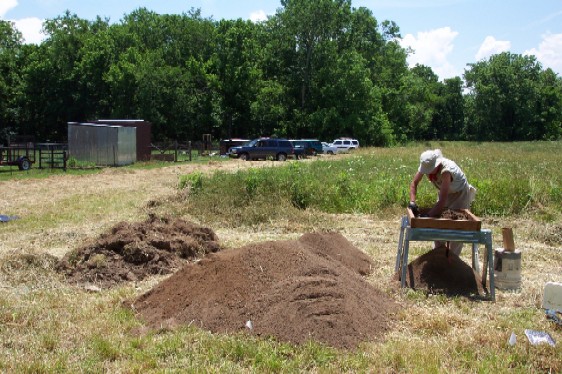


Once again, the day started off more pleasant than one can expect for June in Tennessee -- overcast, not too humid, and with a nice breeze. Our crews made excellent progress in the morning -- making a significant dent in our "second excavation level" (from 10-20 cm below the current ground surface). The skills of recording are practiced each day -- below, closing measurements are being taken at the base of Level 2 in one of the units. As expected, as we proceed beneath the "plow zone," we are finding better preserved artifacts -- including our first several pieces of pottery dating to our period of interest. While not particularly photogenic, the photograph below shows a relatively large broken fragment of a pot or jar used by the native peoples of this site some 600-800 years ago. After lunch, a refreshing brief rain passed over -- our shelters were up to the challenge and we continued work. The only downside to a brief refreshing rain in Tennessee's June is that once it passes -- you get a free membership in a sauna (whether you like it or not)! Less refreshed and invigorated after our dip in the sauna, we also had to deal with a flat tire on one of our most critical pieces of equipment. Our excavations have also begun to annoy some of the local residents. The area where we are working is poorly drained and home to several thousand crawdads (or crayfish as you prefer).
The photo below shows several burrows outlined in yellow in one of our excavation units. While most are unoccupied, a couple still have active residents. In the photo below, the yellow arrow points to the head of one of these local residents -- he/she is bringing up mud from about 30 cm (1 foot) deep and closing off the entrance to the house. By the middle of next week, we'll be down to the main crayfish residence hall -- and will have to relocate this citizen. Our dirtpile continues to grow -- new discoveries await next week!
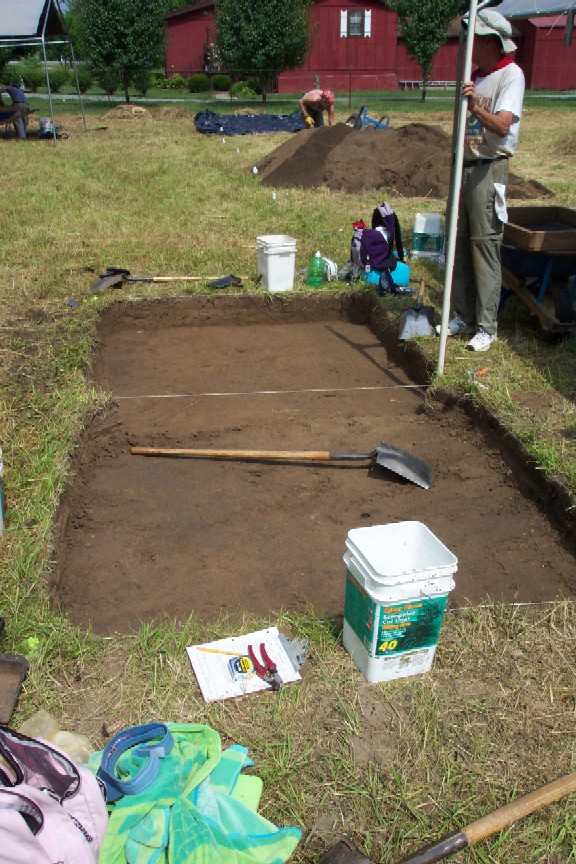




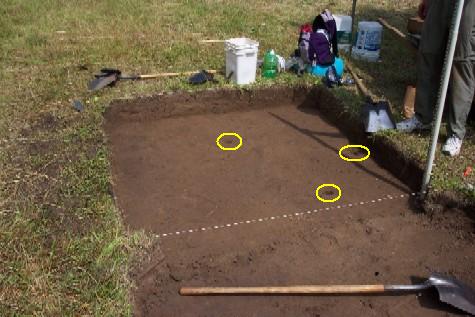


Once again, we were surprised by another lovely June morning (not too hot, not too humid, and slightly overcast). The afternoon did prove to be more typical (pretty hot, pretty humid, and no clouds!). The crew continues to prove one of the hardest working bunch of students in the history of our field school -- all four of our "teams" completed their second excavation level and proceeded into Levels 3 and 4 (20-40 centimeters below the current ground surface). Our excavations have finally caused some of the smaller local crawdad citizens to give up and voluntarily relocate. The little fellow below was carefully retrieved as he abandoned his current home. We moved him to the edge of the field (along with his luggage and furniture). We wish him the best. The really big guys are still in a constant battle with our excavations -- we dig, they keep bringing up more mud and repacking their burrows. In our "northeast units," as we progress deeper into the undisturbed soils beneath the plowed areas, we are finding more and more promising evidence of well preserved evidence of the people who lived here almost 1000 years ago. Below, the dark colored material in the center of the photograph is a large piece of charred wood - a key and critical artifact for archaeologists. Using radiocarbon dating, we can identify the age of the wood within usually about 50-75 years. In this photograph, Tyler is preparing to measure very precisely the depth at which the charcoal was found. In our "southwest units," the crews are proceeding a bit faster -- the soil is these units is much moister and easier to both dig and screen. At about 40 centimeters below the current ground surface, they struck what appears to be a "buried ground surface." Certain types of soil -- humus, loam -- can only form on the surface of the earth. We believe that this dark soil was -- some 200+ years ago -- the "top of the ground." Over the past 150 years -- with plowing, timbering, and erosion upstream -- this old ground surface was buried with silt washed down the creek onto the floodplain. The grayish-clay "spots" in the photo (one circled in yellow) are old crayfish burrows. By carefully watching our current crayfish and their activities (including bringing up the gray clay from near the watertable), we are able to interpret these "stains" in the soil. 




To the trained archaeological eye, that fragment is a portion of the tool shown below. Used by native peoples from about 600-800 years ago, we believe this tool was used to smooth and burnish the pottery pots, jars, bottles, and bowls during manufacture.

As our explorations of this important site continue -- slowly and carefully -- we are developing a better understanding of what happened her (and when). While "discoveries" are important to our project -- the central goal remains to provide students with training in the skills needed to further their careers as archaeologists in the future. And ultimately, the core skills we develop in this course are those that any person would need in any job -- the ability to work as a "team," to settle into a routine that makes the "opening" and "closing" of the day work more efficiently so that we can quickly get to the job at hand and then quickly close out the day. The "teamwork" part is our most critical component -- working together even with folks you don't like (or even maybe detest!). In virtually any job, all of us have to find ways to work together as a "team" to accomplish a goal -- and we also have to find ways to accomplish common goals with those folks that we don't like. Our working conditions are different from a "regular class" -- students have to focus on these skills 8 hours a day without air-conditioning and with bugs plus. Our crew is quickly coming together as that bigger "team" -- keeping our shared goals in mind. Below, two of our teams efficiently practice the "daily routine" of covering our excavations to protect them from the elements. We're down from 45 minutes last week to about 20 this week.

And yes... through the hard labor of our student crew -- the dirt pile continues to grow....

In the morning, I attended the funeral of a dear friend who passed away on Sunday. Thanks to the understanding of the students and the able and capable work of Ms. Emily Beahm (Field Assistant), the course continued in my absence. Everyone worked in our "field lab" washing and examing the artifacts from our first week of work. My thanks to all of them for so graciously understanding this unexpected interruption to our regular schedule -- and working as "a team" to continue our work in my absence. I arrived during their lunch hour. We decided to do our "field trip" across Highway 25 to Bledsoe's Fort Historical Park and to visit the main portion of the mound site for the afternoon. One of the most incredible and unique things about the community of Castalian Springs in Tennessee and across the nation is that we have managed to preserve several hundred acres of land that contains an amazing set of ancient and recent sites. OUr "field trip" this afternoon helped all of us to understand how unique this amazing set of preserved sites really is. We started our tour in Bledsoe's Fort Historical Park -- the only park in Tennessee or anywhere else in our region that contains original homes from the 1790s and one of our only remaining "forts" from the 1780s. The photo below shows the Rogan House -- a traditional Irish stone cottage constructed in the 1790s by Hugh Rogan. This cottage is identical to those found in Ireland in the late 18th century and perhaps one of the only surviving examples in the eastern United States. We proceeded through the park -- examining the many signs and monuments that provide an amazing amount of information on the early settlers (men, women and children; black and white; free and enslaved) who made it possible for us to be here today. We examined the site of our past MTSU excavations at Bledsoe's Fort from the viewing platform at the park. We trekked down the hill to look at the Bledsoe Spring -- the site of our 1995 MTSU field school project. We trekked back up the hillside to visit the "Pioneer Cemetery" -- and the monument to the Bledsoe pioneer families erected in 1903 by their descendants. We then moved across Rock Springs Road to the 132-acre Shoulders farm that has just been purchased by the State of Tennessee as a new park. It contains almost the entire prehistoric Native American town that once flourished here 800 years ago. The photo below shows the enormous central mound as we approach it -- at 25 feet in height and a football field in length, built by native peoples carrying loads of earth in baskets, it is probably the largest "hand built" earthen structure built up to today in Sumner County. And, as we finished our wonderful trek through thousands of years of history in the community of Castalian Springs -- I hope we all left with a better sense of how important our archaeological work this summer will be. As the photo below shows, our afternoon field trip "across the road" ended just before the late afternoon thunderstorms rolled in. Our excavations resume in the morning. More tomorrow.
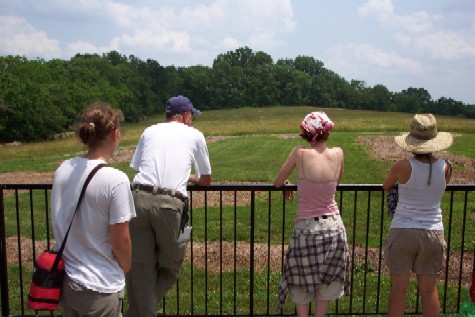
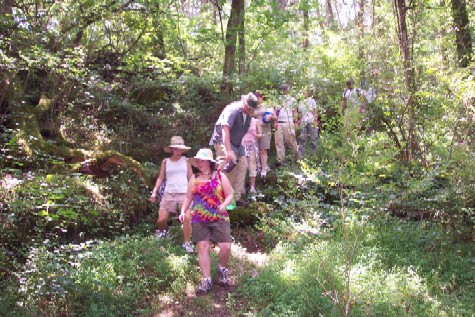



As June days go in Tennessee, today was not a bad one -- the humidity was down and the temperature didn't seem as oppressive. In all of our excavation units, we have encountered a buried "midden" zone. "Midden" is an archaeological term generally referring to a strata (or level of soil) created as a result of human activity. Basically, you can consider it the gradual accumulation of discarded garbage, ash, charcoal, and other items created in and around an area where people live for a considerable period of time. Although in our modern world with trash pickup and notions of "clean yards," middens don't tend to build up very quickly -- in the ancient world, these types of human-created soils build up over the centuries to leave behind a distinctive type of deposit filled with artifacts. In the photograph below, the top of this dark (organically enriched) midden has been fully exposed in one of our southwestern units. At the lower left of the excavation units, you can see the lighter colored non-midden soils where they haven't yet been excavated. In our northeastern set of units, the same dark midden soil is appearing at about the same depth. The photo below shows Kristen, Tyler and Mitch removing the upper lighter color non-midden soil (visible at upper right and left) from a midden zone with a particularly high concentration of charcoal. As we excavate, part of our "job" as archaeologists is to record the different soil layers and interpret how they came to be created. The photograph below shows the "side wall" or "profile view" of one of the excavation units. While subject to change as we learn more, our current interpretation is as follows: (A) a silty clay "strata" or layer of sediment deposited by flooding over the past 100 or so years and probably plowed at some point; (B) a dense clay deposit that appears to have been flood deposited and plowed; (C) a narrow layer of sandy-clay probably deposited during a single flood at some point in the distant past; and (D) the dark midden soil resulting from discard of garbage by native peoples about 600-800 years ago. Students continue to practice new skills and techniques as we proceed into the undisturbed midden zone. Below, Jessica is "skimming" with a flat shovel -- basically, carefully removing a shallow bit of soil leaving a flat and clean surface for us to examine. At times, something of particular interest is noticed and we switch to the "hallmark tool" of the archaeologist -- the pointing trowel. Here, Jessica is exposing a delicate fragment of animal bone -- the midden is rich with animal bone discarded after butchering and meals. Unfortunately, the soil and sediments have not preserved the bone very well - most of it is fragmented and very fragile. The quantity and size of artifacts is increasing as we begin to excavate into the midden. We are now recovering more an dlarger fragments of pottery, stone tools and debris, burned limestone, charcoal and ash. The photograph below shows a nice "blade tool" -- a fragment of chert/flint that has been used as a knife or cutting tool. As always, our training and interests also focus on keeping good records of our excavations -- below, Laura is taking careful notes as she and Gavin (those are his feet!) begin to close out another excavation level.






Today was an incredibly beautiful day for fieldwork in June -- low humidity, not too hot, and a nice breeze for much of the day. Unfortunately, I left home this morning at 5:30 am without my digital camera -- the hour commute prevented my traveling back to pick up that forgotten item. Fortunately, Mitch Bearden (one of the student crew members) was willing and able to loan me his camera for today's photos. Thanks, Mitch! As we had hoped and anticipated, all of our student "teams" are now excavating undisturbed "midden" from about 800 years ago. The size and density of artifacts continues to increase as we proceed deeper into this amazing -- and nearly unique -- archaeological site. We are now recovering hundreds of artifacts each day -- fragments of pottery, stone tool debris, and food bones. The photo below shows a fragment of a pottery jar made by a native potter some 800 years ago -- including the base of the handle once used to lift and carry the pot. Numerous interesting artifacts are popping up here and there -- and the preservation of animal bone is increasing as we excavate deeper. The photograph below shows a pottery marble (the white specks are the crushed mussel shell used as a tempering agent) and a scapula (shoulder bone) from a young deer eaten over 800 years ago. The tiny specks in Ms. Beahm's hand below are fish scales dating back to about 800 years ago. The preservation of information about the lifeways of native peoples at this site centuries ago is amazing. Each day, we are recovering thousands of pieces of information about this town that once housed hundreds of native peoples. We also continue to have good relations with our non-crayfish neighbors. Below, our neighbor to the east is showing off a baby goat born a few hours earlier to some of the students. We had several distinguished visitors today -- the photo below shows from left to right Lee Myers (one of our hosts at Wynnewood State Historic Site), John Broster (Senior Archaeologist with the State Division of Archaeology) and Mike Moore (Assistant State Archaeologist with the Division of Archaeology) on their way to check out our progress. We also had some volunteer assistance today from some alumns of our archaeology program at MTSU -- Michael Creswell and Amanda WOlf. Below, Michael is demonstrating the proper technique for using my ancient (and enormously heavy) full-metal wheelbarrow. Our backdirt pile is growing daily thanks to the hard labors of the students. Each day, we also have to haul our truckload of equipment back and forth from the "digs" in my truck from our storage area. Below, our alum volunteer Amanda (back center) is providing sage advice to Tyler (loading "stuff" in my truck) and to Emily and Ryan (dismantling and packing our transit). Three more weeks to go -- and our excitement continues to build.






Another beautiful day for excavations in Castalian Springs. At the base of Level 5 (50 cm or about 20 inches below the current ground surface), the dark black "midden" soil continues -- interrupted only by the lighter circular stains that represent generations of crayfish burrows. Speaking of which, our crayfish resident continues his efforts to keep our excavations at bay... The midden continues to yield an astounding array of artifacts and information about the inhabitants of this ancient town from several centuries ago. Below, a large rim sherd from a Native American cooking pot... And here, a large fragment of a Native American pan or griddle. The "decoration" on the fragment is the impression of fabric or textiles on the "bottom" of the pan. Just as we sometimes use discarded clothes and other fabrics as rags after they outlive their primary purpose, ancient Mississippian peoples used their discarded fabrics to line the molds for these pans. They could then use the fabrics to lift the pan from the mold. Since the clothes and other textiles created by these peoples rarely survive over the centuries, these impressions in ceramic are often our only way to reconstruct the multitude of everyday and fancy fabrics they created. The midden also continues to produce a remarkably well preserved spectrum of the diet of these ancient peoples. The photo below shows a small sample of the animal bone fragments from today's excavation -- including deer, turkey, and many others. The inhabitants of this ancient town were also harvesting fish and turtles -- perhaps from Lick Creek, but further analysis may show that they were also travelling to the Cumberland River a few miles away. The photo below shows a fragment of turtle shell from an ancient meal. In addition to telling us what they ate, these refuse bones also contain important clues to butchering patterns (from cutmarks left on the bones) and how they used various types of bones as tools. The deer bone in the photo below has been worked in several different ways: the yellow arrow points to a section of bone that has been grooved and then snapped, the blue arrow points to several cut marks, and the white arrow points to a groove cut all the way around the bone with a stone tool. Another week closes down with loading the truck and covering our excavations.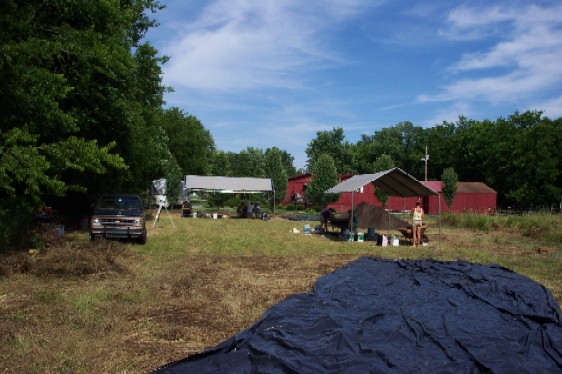








Each field school, we offer opportunities on a limited number of Saturdays for a volunteers to participate in our summer project. Because of the small number of excavation units we have open and the need for careful supervision, we can only accomodate a small number of volunteers. Saturday, June 18 our first volunteer day (held in cooperation with the Middle Cumberland Archaeological Society). The volunteer days also provide opportunities for family and friends to visit and/or participate. Several of the field school students participated as well -- learning skills as "supervisors" of the volunteers. Here, Mike Bradley (Kristen's father) work with her and Mitch completing Level 5 of their excavation unit. As they finished out Level 5, they came down on the top of a complex set of features representing an ancient activity area. Several clusters of ash, burned clay, and charcoal indicate an old "surface" -- the activity area appears confined to the side of the yellow dotted line where the arrow points. While we cannot yet be sure, this may be a portion of a house or other building dating to around A.D. 1200. Work in this area will proceed slowly over the next few days as we attempt to sort out the different concentrations. In the adjacent unit, Emily Reid supervises Logan Williams -- a volunteer -- in screening. While his dad, George Williams, works with Lacey Fleming -- a volunteer and alum of our 2004 field school at the Sam Davis Home. George is a member of the MCAS and has volunteered on many of our summer field projects. At the other end of our excavation area, Gavin and Laura worked with volunteer Joe Bailey starting on Level 6. Here Gavin and Joe are examining a cluster of charcoal and limestone in the center of the excavation unit. The cluster of limestone, charcoal, and burned clay flecks (the darker spot in the middle of the photo below) could have been the remnants of a hearth or firepit used by the ancient inhabitants of the town, but upon closer investigation seems more likely to have been a basket or pot full of debris brought here and dumped from a nearby house. In the adjacent unit, a dense cluster of artifacts was uncovered today. As in the units described above, this level appears to represent an old ground surface -- all of the artifacts are lying flat (rather than on end as if they were in a pit). The yellow arrows point to large fragments of a fabric-impressed pan, while the blue circles surround fragments of animal bone. Other objects not individually identified include fragments of limestone, chert or flint debris (and of course the ubiquitous crayfish holes!). All of the artifacts on this surface were carefully exposed, photographed, and mapped before being removed. Below, Ellis Durham -- one of our long-time volunteers from the Middle Cumberland Archaeological Society -- uses a bamboo splint to carefully expose fragments of pottery and bone. Ellis is assisted by Chris Robbins -- alum of our 1998 and 1999 field schools, 2000 graduate of the MTSU anthropology program, and an experienced archaeological field supervisor. Below, Ellis works with Georgia Dennis and Judy Shook -- both long term volunteers from the MCAS on our field school projects. Georgia is also an alum of our 1999 field school and 2000 graduate of the anthropology program. The excavations continue to produce intriguing insights into the daily lives of native peoples some 800 years ago at this spectacular town. Below, another wonderfully preserved piece of worked animal bone is shown -- it is cut clean across the upper end and beveled and snapped on the lower end. Detailed analysis of this unusually well preserved material in the lab will be conducted as the year proceeds.


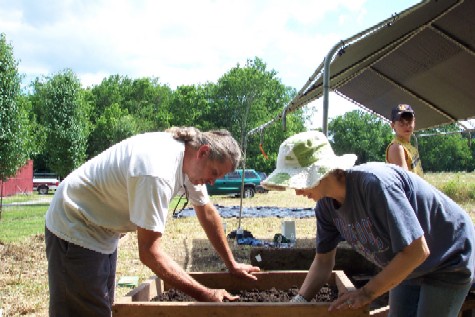







Due to the death of my digital camera on Monday (after five years of "hard labor" on several field projects), I had to run around town in the wee hours of the evening and purchase a new one -- leaving the web pages incomplete for a couple of day! On Monday, we continued work in all of our units -- with the heat and humidity rising!
In the two photos below, Mitch, Kristen, and Tyler continue to work on the series of ash, sand, and charcoal filled features in our northeastern units. More unusual artifacts continue to surface, including the click beetle who emerged during our excavations. He/she offered to bite several of the students, but all declined the offer. In the adjacent unit, the midden continues. Here, Emily is working on a concentration of pottery sherds and bone in the northeastern corner of their unit. We continue to discover remnants of the lives of the people who lived here hundreds of years ago. The photos below show a broken drill and another small arrow point from about A.D. 1250. While the students work diligently, I decided to practice my fishing techniques... Armed with some twine tied with bacon, I've been attempting to lure our crawdad friend out far enough to "catch and release." Thus far, the score is Crawdad 6, Smith 0. I hope the little fellow has enjoyed eating the bacon.

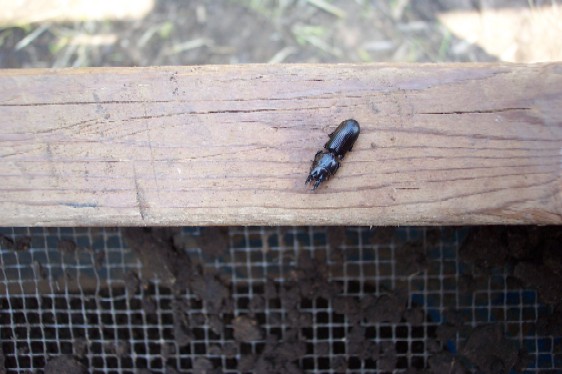
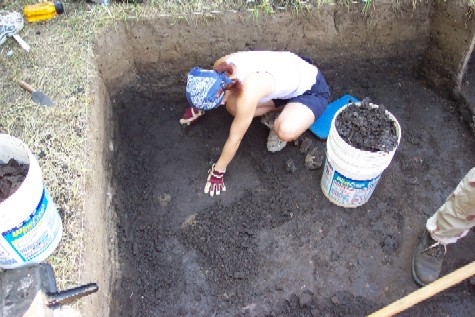



While the days continue to start off fairly nice, the afternoons are increasingly less than "fun" for work in the field. Here, Mitch takes measurements on the series of features in their unit, while Kristen records the information on their forms. Tyler is providing support by double-checking the measurements. During their excavations, the team discovered yet another ceramic "marble" -- it is very unusual to find these artifacts at all during exxcavations. Two in one project is an intriguing mystery for our lab analysis. In our other units, an intriguing concentration of limestone suggests the possible presence of a posthole packed with rock after use. Further investigation will tell us whether our hypothesis is correct. In the southwestern units, we continue to also find large quantities of pottery, stone tool debris, and animal bone. Today, we recovered several thousand artifacts. A small sample of the pottery sherds is shown below... This includes an unusually high percentage of fabric-impressed pans -- while these pans are used for many purposes by ancient Native Americans, they are also often used for evaporating mineral water to extract salt. Since we are right next to the mineral springs, the unusually high numbers of these sherds may be a result of extracting salt for local use and trade. We also continue to recover thousands of fragments of animal bone that will allow us to examine the local environment and how native peoples used it some 800 years ago. We continued our lessons in local floral and fauna today -- a wolf spider with a load of eggs wandered past (creating a lengthy discussion amongst the students on the pros and cons of spiders in general). Since we had a lecture to attend in Nashville at 7:00 pm -- we broke early for the day at 4:00 pm. As always, we turned our "digs" over to our neighorhood watch security force shown below...



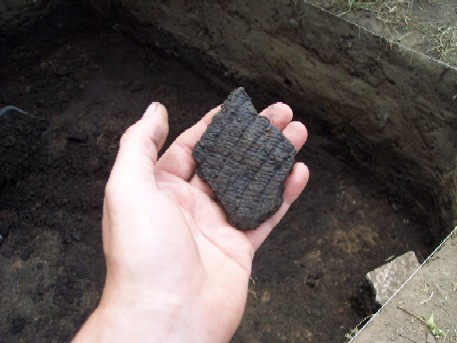



The morning began quite comfortable with an overcast sky and light breeze. The afternoon was not quite so nice to us! An old friend of our project and experienced archaeological worker, Howie Brainerd, showed up today to volunteer -- his help both on the screens and in the pit was appreciated! Howie also brought his grandchildren Katie and William -- we are always excited to involve interested young people in our project. Both worked on the screens and William worked with Grandpa and Gavin in excavating. Here Katie and William are screening with Tiffany. While Howie excavated, Gavin worked on exposing a fragile animal scapula in the same unit. Poorly preserved and fragmented, we needed to carefully document this animal bone in photographs before removing it. As we anticipated, when we tried to remove it from the unit, it disintegrated into several hundred pieces. In the afternoon, we shifted all of the crew to working on finishing out a single excavation unit. Our "backlog" is not in "digging" at this point, but rather in screening the increasingly wet and sticky clay as we approach the watertable. With two "diggers" and five screens working, we should be able to finish this single unit down to 1 meter in depth by Thursday afternoon. Our backdirt pile has reached monumental proportions... More (and hopefully better!) updates over the next few days.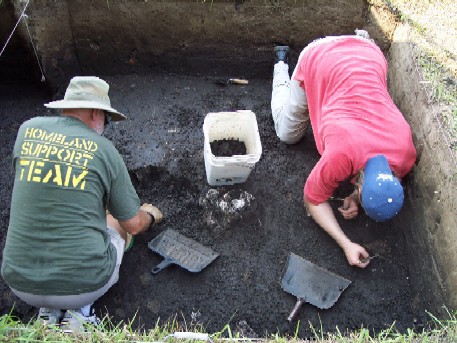




As I drove from Murfreesboro to Castalian Springs this morning, several ominous signs and portents suggested our day would be intensely humid and hot -- banks of fog on the Cumberland River north of Lebanon and indications of an early morning rain as I approached Castalian Springs. When we arrived at our excavation area in the early morning, other omens predicted a difficult day in the field... Not the least of which was the steam rising from our backdirt pile in the morning sun! Fortunately, these predictors of the day were off-base -- by mid-morning, the humidity had dropped by many percentage points. While it was a hot day -- it was not uncomfortable for a mid-June day in Tennessee! Today, we were in a "slow spot" in our digs -- closing out excavation units, dealing with interesting features, and getting ready to open some new excavation areas in the next day or two. We completed excavations in one our units (fondly called N1000E982 in our "grid system"). We reached the base of the "midden" containing the debris discarded by native peoples 8 centuries ago. Beneath this is clay "subsoil" -- soil that formed in place from the decay of limestone over the past millions of years. We did find one "feature" -- a disturbance extending into the subsoil. The darker colored stain just to the upper right of the menu board in the photo below is what we designated "Feature 1." These types of "features" can be cultural (created by humans) or natural (created by plants, animals or natural processes such as erosion). In this case, we remain uncertain as to whether Feature 1 is cultural or natural -- it could be a posthole dug by native peoples long ago or it could be a disturbance left by a tree growing equally long ago. No clear evidence from our investigation of it allows us to determine that. Our interpretation was complicated by the fact that we struck the water table about halfway down in this feature. In the adjacent unit, we also documented, excavated, and recorded Feature 2 -- another possible posthole. After excavation, we think it was just a basketload of limestone dumped by the inhabitants of our ancient native town. Limestone was often used to line hearths and firepits - when it became chalky and soft, they often cleaned out these materials and replaced them with new stone. A reasonable modern analogy would be replacing the briquets in your gas grill -- once they are "worn out," we discard them and replace them with new ones. Work will continue on Friday -- and on Saturday as volunteers work with us.



As our third week closes out, we look back with amazement (and some pride) at how much we have already discovered about the ancient Native American town that once stood at Castalian Springs. Through the dedication and hard labor of our crew, we have proven that the remains of this once bustling ancient community are incredibly well preserved beneath what is now quiet pastures and hayfields. While our four excavation units have barely touched the 16 or more acres of this community -- we have collected thousands of artifacts that will provide new and exciting information about life in Castalian Springs nearly a millenium ago. Today, we completed our excavations in N1000E982 -- at 90 centimeters below the current ground surface. As the photo below illustrates, we have passed beneath the midden containing the artifacts and debris left behind. We will complete excavations in two of our other three units on the next field day. Here, two of our teams work on finishing Level 9 in one of our northeastern units (with assistance from long-time volunteer Howie Brainerd). Elsewhere, we were assisted by three able-bodied volunteers (grandchildren of our old friend Carrie Mabrey). Here William and Wade test their shovel skimming skills. While Keeton assists Laura and volunteer Joe in screening for artifacts... Later in the day, Laura is assisted by volunteer Joe in taking measurements for our records. As we near the bottom of the artifact-bearing midden in their excavations, intriguing artifacts continue to appear in the screens. Below is a fragment of sharpened and polished deer antler. And we continue to recover an amazing set of animal bones that will tell us about the environment in A.D. 1200 and how our ancient friends used it -- including the fragment of turtle shell below. As we complete our current excavation units, we are preparing to open two more units that will consume most of our remaining two weeks. Below, Mike, Emily, and Mitch practice the skills they have learned in preparing these new units for excavation. During lunch, we continued wildlife lessons. As the students have come to appreciate -- knowing the plants and animals that surround us today can inform us in meaningful ways about the ancient past as well. Our brief encounter with the tiny worm below provides a moment for appreciation not only of the archaeological site we are investigating, but also the wonders of the world that we inhabit today. While some would call this an "inch-worm" - we work in metric and instead have dubbed it the "2.54 centimeter worm" (1 inch=2.54 centimeters!). And finally, our efforts in crawdad relocation finally bore fruit today. After many unsuccessfl attempts to lure our friend from his/her hole with bacon... ... we ended with the score of Smith 0, Crawdad 39. Fortunately, field school student Mike Warren stepped in with Plan B -- and ended with Warren 1, Crawdad 0. Angry but uninjured, our behemoth is shown below in full glory... We carefully relocated our friend to the nearby creek -- lowering it from the bridge in a bucket shown below. Two weeks to go in our explorations of the fields of Castalian Springs!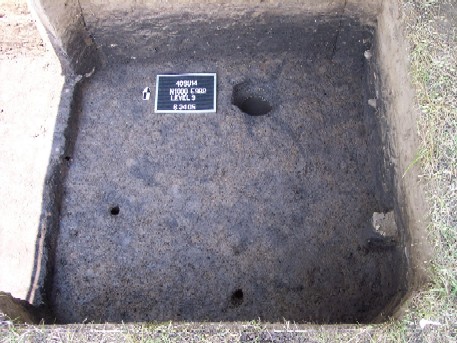











Overall, a nice Saturday for archaeology at Castalian Springs -- it was hot and a bit humid in the afternoon, but nobody showed up today expecting to need a jacket and overcoat! Three students -- Jessica, Gavin, and Tiffany -- helped Emily and me with volunteer day. We had about ten volunteers and made some nice progress and had a great time. Work today focused on starting the two "new" excavations 20 and 40 meters west of our earlier units. Here, Field Assistant Emily Beahm sets up the transit for recording the elevations and other measurements for our project. Today, our volunteers consisted of family members of the student crew and a number of volunteers from the Middle Cumberland Archaeological Society that have supported our project for over a decade. During lunch, the volunteers and crew took a break in the shade in the tree-line. Since we only have two weeks left, we have reduced the size of our excavation units from 2x2 meters to 1x2 meters. This will allow us to get a picture of what is under the ground to the west of our previously investigated areas while still finishing our project on time. Below, volunteers Ellis Durham and Lacey Fleming work on the upper levels of N1008E960... Later in the day, they were joined by crew member Tiffany's family (Mom, sister, and five-year-old niece) in excavating the upper zones of this new area. Twenty meters west, our other crew of students and volunteers worked on another excavation. Here, Jessica and Gavin are working with volunteers Daniel (Jessica's spouse) and the parents of field assistant Emily Beahm. Due to the July 4 holiday next weekend, today was the last of our Saturday volunteer days for this summer session. While we can't always time the "exciting discoveries" part our of field course with volunteer days, they do provide family and friends with a chance to see "hands-on" what archaeology is really like. Today, we found no exciting artifacts -- but we did have a chance to share the process of archaeology and how each new excavation provides us with information about our earlier investigations. Our discoveries today confirm our suspicion that The relatively few prehistoric Native American artifacts in the upper 20 centimeters of our excavations are being transported "up" from below by our crawdad friends. As they carry mud up from their deep burrows, they occasionally bring up a piece of flint along with it. We will all be intrigued to see if our incredibly well-preserved midden in our first four excavation units extends 20 and 40 meters to the west in these new units. We have many questions -- how far does this site extend? How much of the field in which we are working will contain these amazing finds? As always, we appreciate the family, friends and other volunteers that take the time to come out and experience archaeology with us!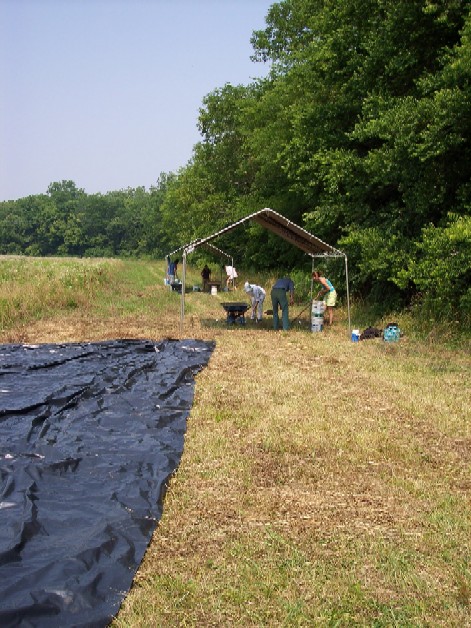





With only two weeks to go, we are working to finish out our first four excavation units. Below Gavin and Mike are removing several centimeters of what we call "sterile subsoil" -- basically, this means we are below the zone where human activity left artifacts for us to find. The dark "midden" soil deposited by ancient Native Americans makes it very difficult to identify features such as pits or postholes until we are beneath the darker soil. The bottoms of the deeper features extend into the lighter colored "subsoil" -- and are easier to spot at that point. Below is a shot of one of the units -- the "oval" indicated in yellow is the bottom of a pit feature. It contains charcoal, ceramic fragments, and other artifacts and will be excavated separately (at least the portion that we have exposed in these two units). The yellow arrows points to a few of the circular dark stains that we will investigate to see if they may be the bottoms of postholes -- or natural features such as tree roots, ancient crawdad burronws, etc. Elsewhere, we finished another excavation unit. The yellow highlights the ca. 40 centimeters of dark midden in this unit -- the lighter colored dirt above is flood-deposited silt and the lighter colored clay below is the subsoil - ending in a relatively dense gravel deposit. One of our excavation units contains a complex series of cultural features that will consume a day or two to investigate and interpret. The yellow semi-circular areas below are probable postholes or pits, while the larger feature on the lower right is a firepit (filled with brighter colored ash). Here's a closeup of the posthole or pit shown on the upper right of the photo above -- note the flecks of fired clay, charcoal and ash. And here's a closeup of the two possible postholes or pits shown on the upper left of the photo above -- the feature on the left is as yet poorly defined, but the feature on the right contains a tightly packed cluster of limestone fragments. And here's a closer shot of the firepit -- it appears to be a large oval or rectangular pit (the edges have been fired through exposure to heat). We think the area shown in blue is a rodent burrow or other later intrusion that has cut into the edge of this larger feature. We will be investigating this feature further in the next couple of days. With only a few days remaining, we will be focusing on drawing, records, and other paperwork to finish out our first four excavation units -- and working diligently to complete the two new units we opened on Saturday. With the threat of scattered showers and storms in the forecast for the next several days, we have to carefully time our work to make sure that we are finished at the end of our project! But, never too busy to pause and appreciate some of the neighbors that have been with us throughout the project -- the photo below shows one of the many red-winged blackbirds that inhabit the field in which we are working. These native songbirds have been a wonderful addition to the daily grind of dirt, sweat, and hard labor.




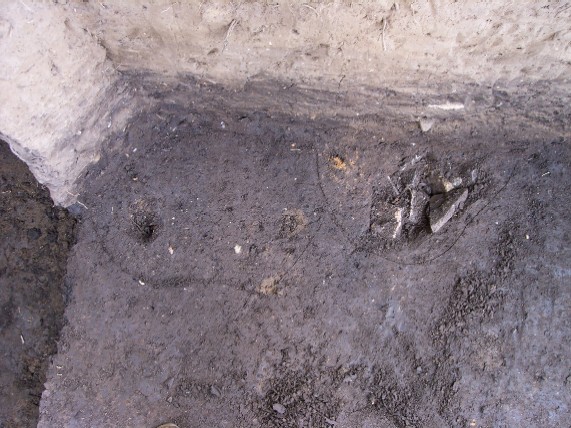
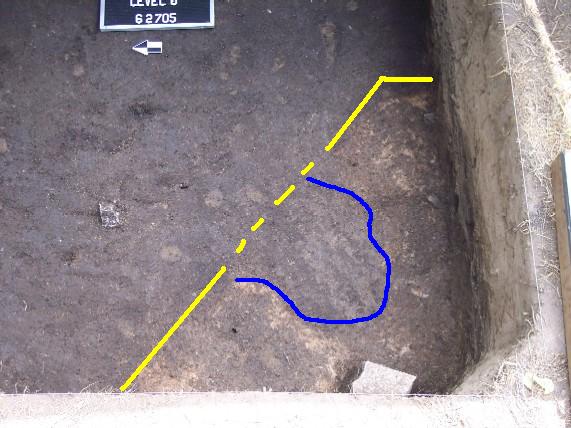

Excavations continued today -- with a lot of interested visitors (John Broster and Mike Moore with the Tennessee Division of Archaeology, Sam and Doris Gilmore with the Bledsoe's Lick Historical Association, and Phil and Shannon Hodge). We had some early morning excitement. We use water sprayers to wet down our profiles for drawing. This A.M., when I went to retrieve them, we discovered a perhaps amorous addition to our sprayer pile. The blue arrows below point to the lovely variegated tubing that runs from the tank to the sprayer handle. The red arrow points to the black racer (snake) I discovered intertwined with the hoses. I was forced to inform him that our hoses were unavailable for brunch or a matinee until after our class ends on July 8. He went on his merry way -- leaving us with the opportunity to debate the relative merits of snakes in general during the morning excavations. We continued work on our two new excavation units, but haven't yet gotten beneath the silt to determine if our midden continues to the west in this field. By tomorrow afternoon, we should have some new information to provide for the web pages. Meanwhile, we continue to try to figure out the complex series of features in our other excavation unit. As we excavated Feature 4 -- our "fire pit" -- it seems to be an "ash dump." As we excavate slowly into it -- trying to figure out what it was -- we have identified what appear to be basket or pot loads of different colors and consistencies of ash. We are taking our time and moving slowly with excavating these features -- we have an "awesome" responsibility to carefully document the remains that our friends from some 9 centuries ago left for us. Amongst the more exciting discoveries today were fragments of corn cobs from this feature... Shown on the tip of trowel below is a fragment of a burned corn cob. In better preserved form, this fragment of corn cob would like more like those below (also from an archaeological site in Middle Tennessee dating to the same time period).... And, in our "ash pits" -- we also found what appears to be the remnants of a charred post (outlined in yellow below). We will focus our investigations on Wednesday more thoroughly on these features, and (hopefully!) will have some better insights in what is going on in this excavation area by the end of the week.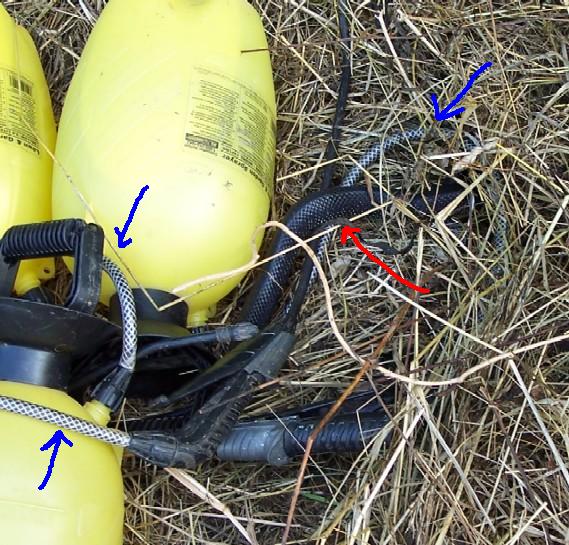




Today was a bit of "a scorcher" for those of us in the middle of a pasture off Highway 25. But, the students are holding up well (with a welcome donation of some popsicles and ice cream by Laura's mom!). Yesterday, we were preparing to excavate What we thought to be the possible remains of a charred post. From the top before excavation, the feature as a circular pattern of charred plant remains. As we investigated however, the feature turned out to be a small pit filled with "gold" for the archaeologist -- charred corn cobs from 8 centuries ago. While very fragile, we extracted a very large sample of cob fragments large enough for study by experts in ancient plant remains. And, for the first time in my twenty years of archaeology in Middle Tennessee, we managed to retrieve a whole corn cob intact. The photograph below shows this magnificent specimen immediately after retrieval. We also began cleaning up several of the other features in this area for further investigation -- including the posthole or small pit filled with limestone and sandstone fragments shown below. As is almost always the case, as we near the end of excavations -- the discoveries begin to pile up quickly. In our other excavation area during cleanup of the walls to draw our profiles, we discovered a massive fragment of a fabric-impressed pan in place. In the photograph below, this large sherd (including the rim of the pan at the top) is outlined in yellow. The lighter colored area outlined in blue is a crawdad hole! This sherd is a piece of a very large pan that was set in a basin in the ground during its use some 800 years ago. In the photograph below, the yellow circle outlines the sherd while the blue lines show the approximate outline of the whole vessel (almost two feet in diameter). The white arrows point to pottery fragments of this vessel still in place. This new discovery supports our belief that the area in which we are working was a production area where water from the adjacent salt/sulphur springs was evaporated to produce salts and minerals valuable for local use and trade. Twenty and forty meters away, our team works on the two new excavation units (far in the background of the photo below). Here was interested to see if the "midden" and artifacts continue the length of the field -- or if we can find a boundary for the village and activity areas. Here, Brandy, Gavin and Laura are working their way through the upper silt zones to see if the artifact-bearing midden is to be found. In the distant background, Ryan, Tiffany and Emily are doing the same.
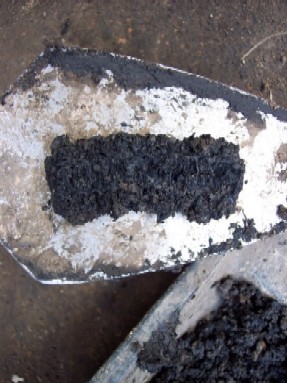





Our weather report for today -- Ugh. Hot and humid in the morning -- hotter and humider in the afternoon. Our thanks to the students for holding up well as the temperature climbs -- and our need to work hard to complete our class continues! As we continue to close out our first four excavation units, we carefully record the "stratigrapphy" in the walls -- interpreting, measuring, and recording the different soil and sediment zones in the walls. Below Gavin and Laura measure and draw the west wall of their excavation unit. Investigations of our "feature filled unit" also continued... Below, the yellow circle encloses the limestone filled posthole or pit -- we'll excavate it on Friday morning. The blue outlines the excavated "ash dump," and the white circle is the excavated small pit that produced our spectacular corn cobs reported yesterday. 40 meters to the west, one of our new excavation units has encountered the artifact-bearing (and crawdad hole bearing) midden discovered in our first four excavation units. However, it has far less artifacts than the midden already investigated. It is producing some interesting artifacts -- including more of our fabric impressed pan sherds and the large fragment of a broken tool shown below. We continue examining the animals and plants of the local area... Below, a photograph of chicory in bloom. And here, a beautiful stag beetle found in one of our excavation units this morning. Since we were all a bit worse for wear after the heat and humidity of the day, we left the field at 3:00 to do some labwork -- washing several of the more than 50 bags of artifacts recovered during our "dig." Thanks to the Bledsoe's Lick Historical Association, we have a handy log cabin nearby that provides a much cooler place to work in the late afternoon heat! Exciting discoveries are also made in the lab as we wash up artifacts -- as we extract them from the dirt, they are often covered with it and don't reveal their secrets until later. Our base philosophy about recovery in the field -- "if in doubt, stick it in the bag." In our brief hour in the lab today, two previously unnoticed super artifacts appeared... The fragment of flint or chert shown below is a very special kind of stone available only on the western course of the Cumberland River in Stewart COunty and along the Tennessee River. Called "Dover Flint" -- this highly prized material was traded throughout the eastern United States. This fragment made its way to Castalian Springs from Dover, Tennessee or thereabouts. And, perhaps the most important discovery of our entire excavation appeared in the lab today. A fragment of a negative-painted plate. These types of painted plates were created using a special technique where the design was "painted" in wax or another similar type of substance, the whole plate was then dipped in a "slip" or watery paste, and then fired. The wax or other substance "burned off" during firing, leaving the image in a "negative" on the plate. This fragment is the first negative-painted plate fragment recovered during professional investigations in Middle Tennessee -- it is most similar to artifacts recovered from the Angel Site in Indiana (like to one shown below). While we have barely scratched the surface of this important late prehistoric Native American town site -- these amazing discoveries demonstrate the incredible significance of this well-preserved site to tell us about life almost 1000 years ago.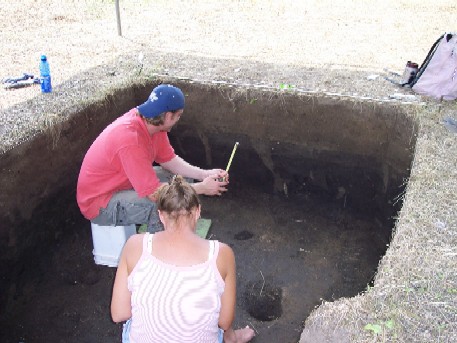









In the morning, excavations continued in our two new "half units." The schematic below shows the placement of our excavations -- the rectangle at the upper right represents two of our adjacent units (N1006E998 and N1004E998). The next rectangle to the left (heading "west") is our other set of adjacent 2x2 meter units (N1000E980 and N1000E982). Our next "half excavation units" (N1006E958 North half; and N1006E938 North half) were placed to see how far the artifact bearing midden continues to the west in this field. Due to time constraints (and the uncut hay to the south), we will not be able to construct a similar picture in that direction this year -- but because this particular site is protected by the Bledsoe's Lick Historical Association, there will always be time in future years to investigate that question! Our strategy has proven successful in providing some additional information about "where we might be" within the boundaries of this ancient Native American town. Excavation Unit N1006E958 (shown below at 70 cm below the ground surface) still contains artifact-bearing midden -- although at a much lower density than our "double units" to the east." The photo below shows the dark midden -- including quantities of the crayfish holes. In excavation Unit N1006E938 located twenty meters to the west, however, we are getting essentially no artifacts at all at the same depth. While not quite as dark colored, The soil in this area is darker than the surface sediments -- and represents a buried ground surface -- but apparently there were little or no prehistoric Native American activities in this part of the site that left artifacts. Of additional interest is the almost total absence of crayfish holes in this excavation unit. While carefully excavating a "dry hole" (i.e. no artifacts) is not nearly as much fun -- the information provided is critical to our understanding of where things "happened" and "didn't happen" in the past. While further research will be needed to confirm our hypotheses, we believe that our excavations are located somewhere in the circle shown in the lower center on the map below from the late 1800s. While somewhat intuitive with the limited information we now have, I suspect that we are outside the town wall in an activity area associated with the springs to the south. In the afternoon, we worked in the field lab washing artifacts -- a bit of a "breather" for everyone on a hot day before a holiday weekend. Only four days left in the field -- next week will be a busy one as we get ready for the "final stretch." Below, Jessica, Kristen and Ryan enjoy wash up a bag of artifacts from earlier excavations. While we have almost 100 bags of "artifacts" from our different units, levels, and features -- we made a good dent in getting these washed this afternoon (and learning about what different types of things look like once cleaned!). Although our policy of "if in doubt put it in the bag" results in lots of rocks and pebbles getting washed -- these are also important indicators of the past history of the different parts of the site. We will record the number and weight of the pebbles and rocks, keep a representative sample, and discard the rest. Amongst the pebbles and rocks, however, are many important artifacts of ancient life in Castalian Springs. As photograph below illustrates, the many fragments of flint, pottery, charred plant remains, and discarded animal bones will eventually give us a much better picture of the lives of the people who once occupied this town. Join us again next week as we begin to wind up the first of what we hope will be many seasons of work at Castalian Springs.





When we arrived this morning, the weekend storms had left water on top of our plastic to "bail" before we could start work. Thanks to our now well-trained and efficient crew -- we got that finished quickly and were able to start work. Our last four days of work will largely involve "finishing up" and "closing down." We have accomplished an amazing amount of work in only five short weeks -- and contributed a great deal of new knowledge about this ancient site. Many years of research will be needed to begin to understand a site as complex and important as this one - we are indeed fortunate that the State of Tennessee has chosen to preserve this site from development so that the time is available to "investigate it right." In our northeastern units with all of the features -- we have finished excavating and recording carefully all of the currently known features. Today, we finished down to the base of Level 7 and began excavations of Level 8. Nothing of major excitement showed up today -- but we will continue until we are certain that we haven't missed anything important here! Far out in the field to the west, we hit the water-table at the base of Level 10 (over 3 feet below the current ground surface). You may be able to see the water seeping up from below in the photo -- our excavations in this area will have to stop here. Part of our work in "closing up" also means making sure that future researchers at this site will always be able to find where we excavated before. Today, we placed four concrete benchmarks that will make sure that someone in the future can find our "N1000E980" unit again ... The photo below shows one of the four benchmarks... We have several important visitors today that are supporters of our current and future projects including (from left to right), Suzanne Hoyal and Mike Moore (Tennessee Division of Archaeology), John Lemmons and Tanya Peres (Dr. Peres is starting at MTSU as an archaeology professor in August and John is her spouse), and John Broster (TDOA). And, our wildlife lessons continue... Over the long holiday weekend, one of our crawdad friend continued to construct a massive mud tower... (We caught one more today, but this one remains elusive!).... And, a cicada stopped by to visit us in the late afternoon... Also known as "locusts" -- these friendly bugs are best known for their giant hatchings on 13 and 17 year cycles. But, some hatch every year -- this one was very friendly and agreed to pose for our web pages.
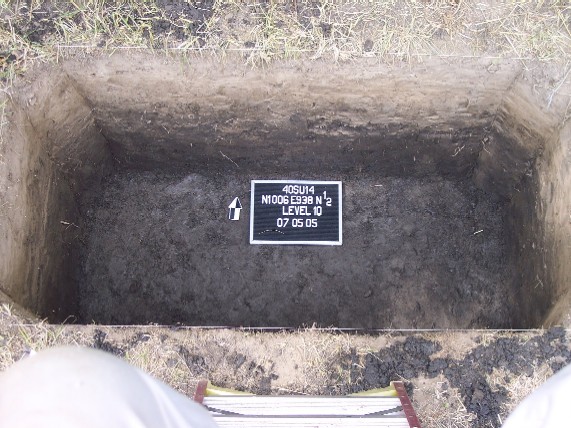





We continue to work diligently to close down our project in the next couple of days -- and make sure that we do full justice to recording each bit of information. The water table rose during the night last night -- when we left yesterday, our unit far in the west field was slightly seeping with water. When we arrived this morning after some heavy rain "upstream," our buckets were floating and several inches of water were in the bottom of this unit. With great "team spirit," crew member Ryan McNutt volunteered to stand in the seeping water to complete our profiles of the walls of this unit. He left behind some size 96 footprints in the bottom -- we hope that this doesn't instigate rumors of a new "Bigfoot Monster" roaming the fields of Castalian SPrings! We also continued finishing up our excavation levels in other units -- and recording their profiles. And started taking some special samples from adjacent to our units -- these small 50x50 cm units are excavated in 5 cm levels (about two inches). All of the dirt is bagged for hand sorting in the laboratory to recover tiny bones, plant seeds, and other small artifacts that are not recovered in our regular screening process. The last few wheelbarrow loads of dirt were added to our pile today. On Thursday, we will be finishing the last of our field recording -- and begin dismantling our project. Our grid nails, pinflags, and other markers will be removed (to prevent future damage to mowing machines), our field station will be packed up and relocated, and we'll try to leave our excavation locale as peaceful as when we found it. On Friday, we'll prepare our excavations for "backfilling" -- the dirt will go back in, and we'll pack our equipment up and haul it back to Middle Tennessee State University. There, the labwork on our many bags of artifacts will commence in earnest.




Today, we worked to finish our last few excavation and recording tasks (on one of the more humid days of our project!). Kristen, Mitch, and Tyler completed excavation of the final level in N1004E998. And then began preparing the sides of the excavation for recording the profiles. The water sprayers help rejuvenate the soil and sediment colors and bring out details that have disappeared as the profile dried out. The profiles in N1004E998 are quite complex -- with a series of ash deposits and other features to record. Elsewhere, other members of the crew worked to complete the two 50-centimeter square column samples -- bagging all of the soil and sediment for detailed examination in the lab. The samples are excavated by trowel in 5-centimeter levels -- requiring about two of the plastic bags per level. Each bag is labeled with the column identification, a cloth label is placed inside the bag, and the bag is tied with another identifying label. Only one more day to close our project down for this summer!
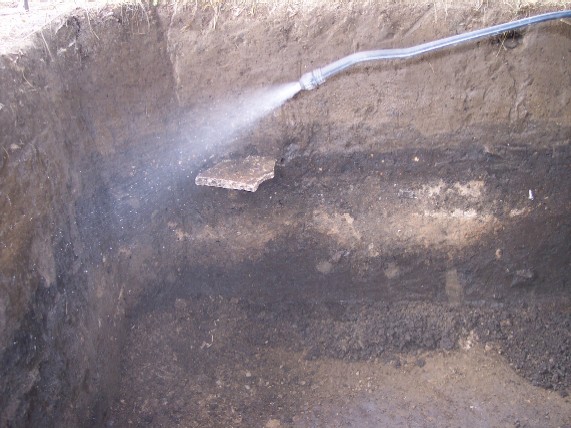





In the morning, we completed the last few bags of our column samples -- these hand-sorted samples will provide detailed information not recovered in our "regular" 1/4-inch screens. One of the completed column samples shows the soil and sediment strata vividly. While Mitch and Kristen completed the final profile of N1004E998. As they put the final touches on their drawings, their crewmates stole their tent shelter and dismantled it... We still took time to admire some of the local insects -- here, one curiously examines a mechanical pencil. As the final scoops of soil came out of the last column sample, the crew dismantled the other tent shelter. Each of our excavation units is lined with plastic - to make it easy for future investigators to tell where we have already dug. In the (hopefully unlikely) event our notes and concrete benchmarks vanish from the historical record, we also place a "message in a bottle" for future reference purposes. Cloths tags like those below are prepared for each excavation unit and sealed in a plastic bottle. A bottle is placed in the southwest corner of each excavation unit. And finally, the dirt goes back in! By noon, we had completed our work in the field -- and loaded our equipment into several vehicles to haul back to our field house. After a lunch together at the field house (including watermelon!), we finished organizing and loading the equipment and artifacts for transport back to Middle Tennessee State University. In a short five weeks, we have gathered a tremendous amount of information about the inhabitants of Castalian Springs around A.D. 1200. And managed to learn quite a bit about "real archaeology" -- the careful and painstaking work that is required to unravel the mysteries of Tennessee's past. While there will be many more years of research before we can really understand the 16-acre town that once stood here, our first year has been a productive one. My thanks to the crew!


